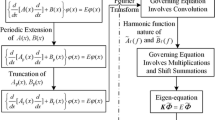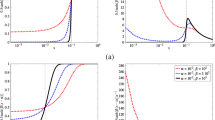Abstract
A novel statement of the Fourier filtering problem based on the use of matrix Fourier filters instead of conventional multiplier filters is considered. The basic properties of the matrix Fourier filtering for the filters in the Hilbert–Schmidt class are established. It is proved that the solutions with a finite energy to the periodic initial boundary value problem for the quasi-linear functional differential diffusion equation with the matrix Fourier filtering Lipschitz continuously depend on the filter. The problem of optimal matrix Fourier filtering is formulated, and its solvability for various classes of matrix Fourier filters is proved. It is proved that the objective functional is differentiable with respect to the matrix Fourier filter, and the convergence of a version of the gradient projection method is also proved.
Similar content being viewed by others
References
J. W. Goodman, Introduction to Fourier Optics (McGraw Hill, New York, 1968).
E. V. Degtiarev and M. A. Vorontsov, “Spatial filtering in nonlinear two-dimensional feedback systems: Phasedistortion suppression,” J. Opt. Soc. Am., Ser. B 12, 1238–1248 (1995).
E. W. Justh, M. A. Vorontsov, G. Garhart, L. A. Beresnev, and P. S. Krishnapasad, “Adaptive optics with advanced phase contrast techniques. Part II: High resolution wavefront control,” J. Opt. Soc. Am. A 18, 1300–1311 (2001).
A. V. Larichev, I. P. Nikolaev, and V. I. Shmal’gauzen, “Optical dissipative structures with a controlled spatial period in a nonlinear system with a Fourier filter in the feedback loop,” Kvant. Elektron. 23 (10), 894–899 (1996).
A. V. Larichev, I. P. Nikolaev, and P. Violino, “LCLV-based system for high resolution wavefront correction: Phase knife as a feedback intensity producer,” Opt. Commun. 138, 127–135 (1997).
I. P. Nikolaev, A. V. Larichev, and V. I. Shmal’gauzen, “Controlled optical structures in a nonlinear system involving the suppression of low spatial frequencies in the feedback loop,” Quantum Electron. 30, 617–622 (2000).
A. V. Larichev, I. P. Nikolaev, S. Costamagna, and P. Violino, “Advanced phase knife technique,” Opt. Commun. 121, 95–102 (1995).
B. Heise, M. Reinhardt, S. Schausberger, S. Hauser, S. Bernstein, and D. Stifter, “Fourier plane filtering revisited— analogies in optics and mathematics,” Sampling Theory in Signal & Image Proc. 13 (3), 231–248 (2014).
R. Martin, G.-L. Oppo, G. K. Harkness, A. J. Scroggie, and W. J. Firth, “Controlling pattern formation and spatio-temporal disorder in nonlinear optics,” Optics Express 1 (1), 39–44 (1997).
S. J. Jensen, M. Schwab, and C. Denz, “Manipulation, stabilization, and control of pattern formation using Fourier space filtering,” Phys. Rev. Lett. 81, 1614–1617 (1998).
M. Schwab, M. Saffman, C. Denz, and T. Tschudi, “Fourier control of pattern formation in an interferometric feedback configuration,” Opt. Commun. 170, 129–136 (1999).
G. K. Harkness, G.-L. Oppo, E. Benkler, M. Kreuzer, R. Neubecker, and T. Tschudi, “Fourier space control in an LCLV feedback system,” J. Opt. B.: Quantum Semiclass. Opt. 1, 177–182 (1999).
G.-L. Oppo, R. Martin, A. J. Scroggie, G. K. Harkness, A. Lord, and W. J. Firth, “Control of spatio-temporal complexity in nonlinear optics,” Chaos, Solitons Fractals 10, 865–874 (1999).
M. Pesch, E. G. Westhoff, T. Ackermann, and W. Lange, “Direct measurement of multiple instability regions via a Fourier filtering method in an optical pattern forming system,” Phys. Rev., Ser. E 68 (016209) (2003).
B. Gutlich, R. Neubecker, M. Kreuzer, and T. Tschudi, “Control and manipulation of solitary structures in a nonlinear optical single feedback experiment,” Chaos 13 (1), 239–246 (2003).
L. A. Poyneer, B. A. Macintosh, and J.-P. Veran, “Fourier transform wavefront control with adaptive prediction of the atmosphere,” J. Opt. Soc. Am., Ser. A 24, 2645–2660 (2007).
M. Nagashima and B. Agrawal, “Application of complex-valued FXLMS adaptive filter to Fourier basis control of adaptive optics,” in Proc. of the American Control Conference (CA, USA, San Francisco, 2011), pp. 2933–2944.
M. M. Potapov and K. A. Chechkina, “On a model of the amplitude-phase filtering in a nonlinear optical system with a feedback,” Vestn. Mosk. Univ., Ser. 15, Vychisl. Mat. Kibern., No. 4, 31–36 (1997).
A. V. Razgulin and V. A. Chushkin, “On the optimal Fourier filtration for a class of models of nonlinear optical systems with a feedback,” Comput. Math. Math. Phys. 44, 1528–1538 (2004).
A. V. Razgulin, “Projection-difference method for controlled Fourier filtering,” Comput. Math. Modeling 23 (1), 56–71 (2012).
M. A. Vorontsov, N. I. Zheleznykh, and V. Yu. Ivanov, “Transverse interactions in 2-D feedback non-linear optical systems,” Opt. Quantum Electron. 22, 501–515 (1990).
V. Yu. Ivanov, A. V. Larichev, and M. A. Vorontsov, “One-dimensional rotatory waves in the optical systems with nonlinear large-scale field interactions,” Proc. SPIE Int. Soc. Opt. Eng. 1402, 145–153 (1991).
S. A. Akhmanov, M. A. Vorontsov, V. Yu. Ivanov, A. V. Larichev, N. I. Zheleznykh, “Controlling transversewave interactions in nonlinear optics: generation and interaction of spatiotemporal structures,” J. Opt. Soc. Amer., Ser. B 9 (1), 78–90 (1992).
A. V. Razgulin, “On self-oscillations in a nonlinear parabolic problem with transformed argument,” Zh. Vychisl. Mat. Mat. Fiz. 33 (1), 69–80 (1993).
A. V. Razgulin, “Rotatory waves in an optical system with a two-dimensional fedback,” Mat. Model. 5 (4), 105–119 (1993).
A. L. Skubachevskii, “On the Hopf bifurcation for the quasi-linear parabolic functional-differential equation,” Differ. Uravn. 34, 1394–1401 (1998).
A. L. Skubachevskii, “Bifurcation of periodic solutions for nonlinear parabolic functional differential equations arising in optoelectronics,” Nonlinear Analys: TMA 32 (2), 261–278 (1998).
V. A. Chushkin and A. V. Razgulin, “Stationary structures in the functional-differential diffusion equation with the reflection of the spatial argument,” Vestn. Mosk. Univ., Ser. 15, Vychisl. Mat. Kibern., No. 2, 13–20 (2003).
E. P. Belan and O. B. Lykova, “Rotating structures in a parabolic functional-differential equation,” Differ. Equations 40, 1419–1430 (2004).
M. M. Potapov, “The nonlinear optics equation with transformations of the independent variable considered as control,” Vestn. Mosk. Univ., Ser. 15, Vychisl. Mat. Kibern., No. 3, 1316 (1997).
A. V. Razgulin, “A class of parabolic functional-differential equations of nonlinear optics,” Differ. Equations 36, 449–456 (2000).
A. V. Razgulin, “Parabolic functional differential equations with a controlled transformation of spatial arguments,” Dokl. Math. 72, 551–554 (2005).
A. V. Razgulin, “The problem of control of a two-dimensional transformation of spatial arguments in a parabolic functional-differential equation,” Differ. Equations 42, 1140–1155 (2006).
A. V. Razgulin and I. B. Roganovich, “Convergence of the projection difference scheme for the nonlinear parabolic equation with transformed spatial argument,” Comput. Math. Modeling 12 (3), 262–270 (2001).
A. V. Razgulin, “Approximation of the problem of controlling arguments transformation in a nonlinear parabolic equation,” Comput. Math. Math. Phys. 41, 1752–1764 (2001).
A. V. Razgulin, “Projection difference scheme for a parabolic functional differential equation with two-dimensional transformation of arguments,” Comput. Math. Math. Phys. 45, 1780–1791 (2005).
V. A. Grebennikov and A. V. Razgulin, “Weighted estimate for the convergence rate of a projection difference scheme for a quasilinear parabolic equation,” Comput. Math. Math. Phys. 51, 1208–1221 (2011).
H. Brezis, Functional Analysis, Sobolev Spaces and Partial Differential Equations (Springer, London,2010).
J-L. Lions, Quelques méthodes de résolution des problèmes aux limites non linéaires (Dunod, Paris, 1969; Mir, Moscow, 1972).
J-L. Lions and E. Magenes, Problèmes aux limites non homogènes et applications (Dunod, Paris, 1968; Mir, Moscow, 1971).
N. Dunford and J. T. Schwartz, Linear Operators: Spectral Theory (Interscience, New York, 1958; Mir, Moscow, 1966).
M. M. Lavrent’ev and L. Ya. Savel’ev, Operator Theory and Ill-Posed Problems (Institut Matematiki, Novosibirsk, 2010) [in Russian].
F. P. Vasil’ev, Optimization Methods (Faktorial, Moscow, 2002) [in Russian].
A. V. Razgulin, “Projection-gradient method for quasidifferentiable functionals with Hölder-continuous gradient,” Moscow Univ. Comput. Math. Cybernet. 30, 10–13 (2006).
Ya. I. Al’ber, “On the minimization of functionals of the class on bounded sets,” Ekon. Mat. Metody 16, 185–190 (1980).
Author information
Authors and Affiliations
Corresponding author
Additional information
Original Russian Text © A.V. Razgulin, S.V. Sazonova, 2017, published in Zhurnal Vychislitel’noi Matematiki i Matematicheskoi Fiziki, 2017, Vol. 57, No. 9, pp. 1403–1420.
Rights and permissions
About this article
Cite this article
Razgulin, A.V., Sazonova, S.V. On the matrix Fourier filtering problem for a class of models of nonlinear optical systems with a feedback. Comput. Math. and Math. Phys. 57, 1385–1403 (2017). https://doi.org/10.1134/S0965542517090123
Received:
Published:
Issue Date:
DOI: https://doi.org/10.1134/S0965542517090123




